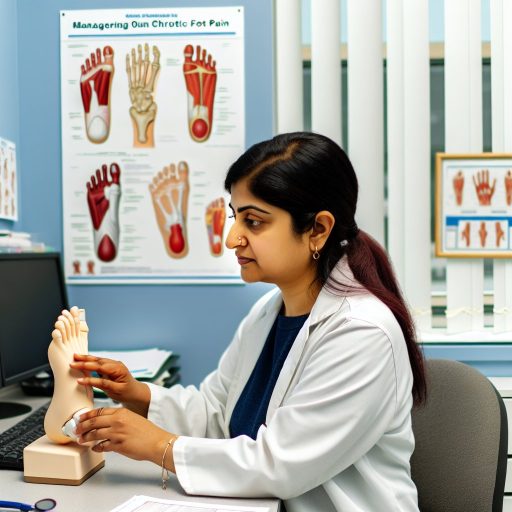Introduction to Chiropractic Care and Its Importance for Posture and Back Pain Relief
Chiropractic care focuses on the diagnosis and treatment of musculoskeletal disorders.
It primarily aims to enhance the function of the spine and nervous system.
Many individuals suffer from poor posture and chronic back pain.
Chiropractic treatments can help alleviate these issues effectively.
Research shows that proper spinal alignment improves overall health.
Therefore, it is crucial to seek professional chiropractic care.
Understanding Posture
Posture refers to the position of the body while standing, sitting, or lying down.
Good posture maintains the natural curves of the spine.
Conversely, poor posture can lead to serious health problems.
It often causes muscle strain, joint pain, and nerve compression.
Chiropractors assess posture and develop personalized treatment plans.
The Relationship Between Posture and Back Pain
Back pain is often linked to muscle imbalances caused by poor posture.
When posture is compromised, uneven pressure affects the spine.
Over time, this can lead to chronic pain and discomfort.
Chiropractic care helps restore alignment and balance.
Additionally, it incorporates exercises to strengthen core muscles.
Benefits of Chiropractic Care for Back Pain Relief
Chiropractic adjustments relieve pressure on nerves and disks.
This promotes optimal movement and reduces pain levels.
Patients often report improved range of motion after treatment.
Furthermore, chiropractic care encourages patient education.
Chiropractors provide guidance on maintaining proper posture.
Integrating Chiropractic Care into Daily Life
Integrating chiropractic care can enhance overall well-being.
Regular adjustments help keep the spine aligned.
Additionally, practicing mindful posture during daily activities is essential.
Incorporating strengthening exercises can prevent future issues.
Unlock Your Career Potential
Visualize a clear path to success with our tailored Career Consulting service. Personalized insights in just 1-3 days.
Get StartedUltimately, commitment to chiropractic care leads to long-term benefits.
Understanding the Anatomy of the Spine and Its Role in Posture
Structure of the Spine
The spine consists of 33 individual vertebrae.
These are stacked to form the spinal column.
Each vertebra plays a crucial role in supporting the body.
They protect the spinal cord, which transmits signals to the brain.
The spine is divided into different regions: cervical, thoracic, lumbar, sacral, and coccygeal.
Cervical Region
The cervical region contains seven vertebrae from C1 to C7.
It supports the head and allows for its movement.
Proper alignment in this region is essential for reducing neck pain.
Thoracic Region
The thoracic region consists of 12 vertebrae.
These vertebrae connect to the ribs and protect the heart and lungs.
Maintaining correct posture in this area is important to prevent back pain.
Lumbar Region
The lumbar region has five vertebrae, known for their strength.
This section supports much of the body’s weight.
Improper posture here can lead to significant discomfort.
Role of Intervertebral Discs
Intervertebral discs act as shock absorbers between vertebrae.
They help maintain flexibility and stability of the spine.
Healthy discs are crucial for optimal spinal function.
Importance of Spinal Curvature
The spine has natural curves that aid in weight distribution.
These curves enhance balance and support upright posture.
Excessive curvature may lead to conditions such as lordosis or kyphosis.
Posture and Its Impact on Health
Good posture maintains the natural alignment of the spine.
This alignment reduces strain on muscles and ligaments.
Proper posture can lead to enhanced respiratory function.
Chiropractic Care for Posture Improvement
Chiropractic adjustments can correct spinal misalignments.
These adjustments aim to restore proper posture and balance.
Regular chiropractic visits may help alleviate chronic back pain.
Common Causes of Poor Posture and Back Pain
Poor posture results from several everyday behaviors and habits.
Understanding these causes can help in addressing the issues.
Prolonged Sitting
Sitting for long periods impacts spinal alignment.
This often leads to muscle imbalances and discomfort.
Office workers are particularly at risk due to desk setups.
Additionally, using computers without ergonomic adjustments can exacerbate this issue.
Improper Lifting Techniques
Many individuals lift heavy items incorrectly.
This can strain the back and result in injury.
It is crucial to use proper techniques when lifting.
Keeping the load close to the body reduces stress on the spine.
Lack of Physical Activity
A sedentary lifestyle contributes to weak back muscles.
Weak muscles cannot support the spine effectively.
Coupled with weight gain, this leads to increased back pain.
Incorporating regular exercise can strengthen these muscles.
Poor Sleeping Posture
How you sleep also affects your posture.
Sleeping on an unsupportive mattress can lead to back pain.
Using the wrong pillow height can strain the neck and spine.
Consider maintaining a neutral spine alignment while sleeping.
Stress and Tension
Stress can lead to muscle tightness in the back.
This tension may cause chronic discomfort over time.
Learning relaxation techniques can help alleviate stress-related pain.
Regular stretching and mindfulness practices improve overall back health.
Delve into the Subject: Benefits Of Seeing An Audiologist Regularly
How Chiropractic Adjustments Improve Spinal Alignment and Posture
The Science Behind Spinal Alignment
Spinal alignment is crucial for overall health.
When the spine is aligned properly, the body functions optimally.
Chiropractic adjustments realign the vertebrae in the spine.
This alignment reduces pressure on the nervous system.
As a result, this can lead to decreased pain and tension.
Benefits of Proper Posture
Good posture reduces the strain on muscles and ligaments.
It enhances breathing and circulation in the body.
Additionally, proper posture boosts digestion.
Chiropractic care can help restore and maintain good posture.
Patients often experience increased energy and focus.
Chiropractic Techniques for Alignment
Chiropractors use various techniques to improve spinal alignment.
Manual adjustments are the most common method.
They apply controlled force to specific joints.
This helps restore proper alignment in the spine.
Other techniques include mobilization and traction.
Individualized Treatment Plans
Each patient requires a unique approach to chiropractic care.
Chiropractors evaluate posture and medical history thoroughly.
Based on findings, they create personalized treatment plans.
These plans address specific alignment issues.
Consistent adjustments lead to improved posture and relief from pain.
The Role of Preventive Care
Preventive care is essential for maintaining spinal health.
Regular chiropractic visits can catch issues early.
This can prevent chronic pain and misalignment from developing.
Chiropractors often provide exercises to strengthen supporting muscles.
Furthermore, they educate on proper ergonomics in daily activities.
Learn More: Kinesiology’s Role in Workplace Ergonomics and Safety
Benefits of Regular Chiropractic Visits for Long-Term Back Pain Management
Holistic Pain Relief
Chiropractic care provides holistic pain relief for back pain sufferers.
By addressing underlying issues, patients can experience long-lasting wellness.
Regular adjustments help reduce pain intensity significantly.
This method decreases reliance on medication and enhances overall health.
Improved Posture
Regular chiropractic visits promote better posture.
Good posture alleviates strain on the back and promotes a healthier spine.
Chiropractors teach techniques to maintain optimal posture throughout daily activities.
As posture improves, the likelihood of future back pain decreases.
Enhanced Mobility
Chiropractic adjustments enhance mobility in the spine and joints.
This increased range of motion benefits athletes and active individuals alike.
Furthermore, enhanced mobility leads to more effective physical activities.
As a result, patients report higher satisfaction with their fitness routines.
Stronger Musculoskeletal System
Chiropractic care strengthens the musculoskeletal system over time.
This enhancement leads to greater resilience against injuries.
Regular adjustments promote muscle balance, which is crucial for stability.
With a balanced musculoskeletal system, individuals can perform daily tasks more effectively.
Preventive Care
Regular chiropractic visits serve as preventive care for back issues.
Early intervention helps catch potential problems before they worsen.
Routine care encourages patients to adopt healthier lifestyles and practices.
Ultimately, preventive measures lead to reduced healthcare costs and improved quality of life.
Explore Further: How To Build A Career In Speech-Language Pathology
Assessment Techniques Used by chiropractors to Evaluate Posture
Observation and Visual Assessment
Chiropractors start with a thorough visual assessment of the patient’s posture.
They look for any visible misalignments in the spine.
Additionally, they observe how the patient holds their body while standing and sitting.
This observation helps identify areas of tension and imbalance.
Palpation Techniques
Palpation is a critical assessment method in chiropractic care.
Chiropractors use their hands to feel the spine and surrounding areas.
This technique reveals muscle tension and joint restrictions.
Furthermore, palpation helps chiropractors understand the condition of the soft tissues.
Posture Analysis Tools
Many chiropractors utilize specialized tools for posture analysis.
Digital posture analysis systems can provide detailed reports.
These systems often measure the angles and alignment of the spine.
Consequently, they offer a comprehensive view of postural health.
Range of Motion Testing
Assessing range of motion is vital for understanding limitations.
Chiropractors evaluate how well the patient can move their joints.
This assessment highlights areas needing improvement.
Range of motion tests also track progress during treatment.
Functional Movement Evaluations
Functional movement evaluations reveal how posture affects daily activities.
Chiropractors assess movements such as bending, lifting, and twisting.
This insight helps them create a targeted treatment plan.
Additionally, it informs patients about recommended lifestyle adjustments.
Learn More: Speech Pathology Services Covered In Canadian Healthcare

Complementary Therapies Offered in Chiropractic Clinics for Enhanced Pain Relief
Therapeutic Massage
Therapeutic massage targets muscle tension effectively.
It promotes relaxation and enhances circulation.
This therapy can reduce pain and improve recovery times.
Rehabilitation Exercises
Rehabilitation exercises strengthen supporting muscles and improve flexibility.
Chiropractors customize exercise regimens to meet individual needs.
Patients often see quicker recovery from injuries with these exercises.
Cold and Heat Therapy
Cold therapy reduces inflammation and numbs painful areas.
Heat therapy relaxes tense muscles and promotes blood flow.
Using both therapies together can optimize pain relief.
Electrotherapy
Electrotherapy uses electrical currents to alleviate pain.
This approach can stimulate muscles and improve blood circulation.
Patients often experience immediate relief from discomfort.
Nutritional Counseling
Nutritional counseling supports overall health and recovery.
Chiropractors provide tailored dietary plans for clients.
Improving diet can enhance the effectiveness of chiropractic care.
Mindfulness and Relaxation Techniques
Mindfulness practices help in managing stress and pain perception.
Relaxation techniques promote a holistic approach to well-being.
These methods support physical and emotional recovery.
Acupuncture
Acupuncture can complement chiropractic adjustments effectively.
This ancient practice alleviates pain by balancing energy flow.
Many patients find relief from chronic pain through acupuncture.
Tips for Maintaining Good Posture in Daily Life and at Work
Stay Aware of Your Posture
Regularly check your posture throughout the day.
Set reminders to maintain awareness, especially when sitting.
Use ergonomic mirrors to help evaluate your posture.
Create an Ergonomic Workspace
Adjust your chair height to keep your feet flat on the floor.
Position your computer monitor at eye level to reduce neck strain.
Utilize a chair with proper lumbar support for your lower back.
Take Frequent Breaks
Set a timer to remind yourself to take breaks every hour.
During breaks, stand up and stretch or walk around.
Incorporate simple stretches to relieve tension in your muscles.
Practice Correct Sitting Techniques
Sit all the way back in your chair with your back against the support.
Keep your knees at a 90-degree angle with your feet flat.
Avoid crossing your legs to maintain equal pressure on both sides.
Incorporate Movement into Your Day
Make it a habit to stand or walk while talking on the phone.
Use stairs instead of elevators to engage your muscles.
Consider a standing desk for part of your workday.
Focus on Strengthening Core Muscles
Incorporate core-strengthening exercises into your routine.
Consider activities like yoga or Pilates for flexibility and strength.
A strong core supports better posture and reduces back pain.
Utilize Supportive Footwear
Wear shoes that provide adequate support and cushioning.
Avoid high heels or unsupportive footwear for prolonged periods.
Consider orthotic inserts for additional support if needed.
Patient Testimonials: Success Stories of Chiropractic Care for Posture and Back Pain
Transforming Lives Through Chiropractic Care
Many patients have experienced life-changing benefits from chiropractic care.
They often report significant improvements in posture and reduction in back pain.
Here are some inspiring testimonials from individuals who have undergone treatment.
Emily’s Journey to Pain Relief
Emily struggled with chronic back pain for years.
After starting chiropractic sessions, she noticed a difference within weeks.
Now, she enjoys an active lifestyle without constant discomfort.
She states, “Chiropractic care changed my life. I feel like myself again.”
Mark’s Posture Improvement
Mark had poor posture due to long hours at a desk job.
He decided to seek chiropractic care for help.
After a few sessions, his posture improved significantly.
Mark shares, “I feel more confident standing and walking. It’s amazing!”
Sarah’s Experience with Neck Pain
Sarah experienced persistent neck pain that affected her daily activities.
She turned to chiropractic treatment for relief.
Now, she enjoys pain-free movement in her neck and shoulders.
“I wish I had done this sooner,” she admits.
Greg’s Athletic Performance Boost
Greg is an avid athlete who sought chiropractic care to enhance his performance.
After regular adjustments, he noticed improved flexibility and strength.
He says, “Chiropractic has taken my training to the next level.”
Why Choose Chiropractic Care?
Chiropractic care offers unique advantages for those suffering from posture and back pain.
It focuses on adjustments to align the spine and improve function.
Additionally, it promotes overall health and wellness.
Hear More Success Stories
Chiropractic care has countless success stories just like these.
Patients of all ages have shared their journeys to health and well-being.
Consider reaching out to a local chiropractor to begin your own success story.
Additional Resources
Effectiveness and Economic Evaluation of Chiropractic Care for the …
Spinal Manipulative Therapy and Other Conservative Treatments for …




